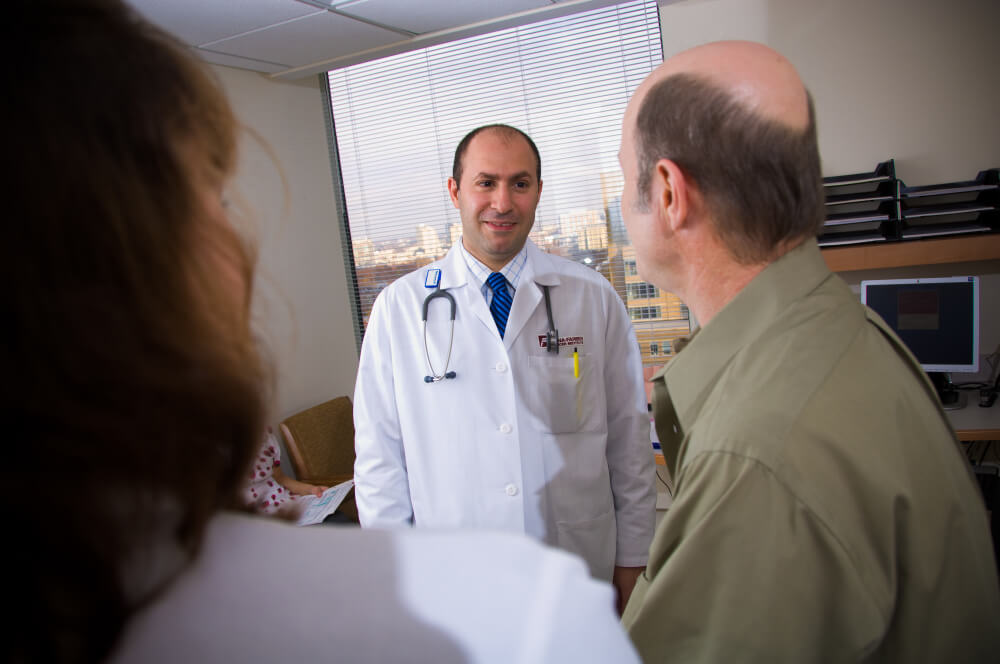- While a small number of men with testicular cancer may have pain in the testicle, it is not a reliable indicator of the disease.
- If you feel a mass, heaviness of a testicle, or difference in size between the two testicles, and if they used to be the same size, you should see your primary care physician or a urologist.
Men who notice a testicle lump, heaviness, or pain in the testicle are often not convinced to see a doctor until a partner insists, but men should take note of changes in the testicles, according to Mark Pomerantz, MD, a medical oncologist in the Lank Center for Genitourinary Oncology at Dana-Farber/Brigham and Women’s Cancer Center.
“Unlike with breast cancer, where many women feel lumps that turn out not to be cancer, most men don’t feel a lump, they just notice the testicle is different somehow,” says Pomerantz, who adds that men who do find lumps may notice that they stick out or feel like a marble within the testicle, but are rarely painful.
“Any man who feels a mass, heaviness of a testicle, or difference in size between the two testicles, if they used to be the same size, should see his primary care physician or a urologist to have a testicular ultrasound,” Pomerantz notes.

It’s important for men to take note of these changes so they can tell their doctor, many of whom don’t check the testicles or may not know what they’re looking for. If men report that they have noticed changes, doctors will order an ultrasound to test for testicular cancer, which is highly curable when found early.
Read more:
- How Does Testicular Cancer Affect Fertility and Sexuality?
- Five Things You Need to Know About Men’s Health/Cancer Screenings
While a small number of men with testicular cancer may have pain in the testicle, it is not a reliable indicator of the disease, according to Pomerantz. Pain and changes may also be caused by cysts in the epididymis, a tube that runs next to the testicle and tends to be prone to cysts. Discomfort can also be caused by a blockage in tubes that run out of the testicle, called a spermatocele, which can cause swelling. In rare cases, men may also experience painful, but non-cancerous, testicle infections.
How do I perform a testicular self-exam?
“Men should do testicular self-exams every month, looking for differences in size or consistency between the two testicles,” says Pomerantz, who recommends taking 30 seconds to examine the testicles with soapy hands in the shower.
Men who have an undescended testicle, or one that is smaller than the other, should pay extra close attention, as those testicles are more prone to developing cancer.
All changes, whether a lump or otherwise, should be taken seriously and evaluated by a doctor.
What are other signs and symptoms of testicular cancer?
In addition to pain or discomfort in a testicle or in the scrotum, the signs and symptoms for testicular cancer include:
- Painless lump or swelling in either testicle (most common)
- Dull ache in the lower abdomen or the groin
- Sudden build-up of swelling in the scrotum
- Back pain
About the Medical Reviewer

Dr. Mark Pomerantz is a medical oncologist at the Dana-Farber Cancer Institute. Dr. Pomerantz received his undergraduate degree from Yale University and his medical degree from Stanford University. He trained in Internal Medicine at Brigham and Women's Hospital in Boston, Massachusetts. He then pursued a fellowship in Medical Oncology at the Dana-Farber Cancer Institute in Boston. Dr. Pomerantz received his post-doctoral training in cancer genetics with Dr. Matthew Freedman at the Dana-Farber Cancer Institute and the Broad Institute of Harvard and MIT. He is on faculty at the Dana-Farber Cancer Institute in the Lank Center for Genitourinary Oncology.
